
Palms is a community in the Westside region of Los Angeles, California, founded in 1886 and the oldest neighborhood annexed to the city, in 1915. The 1886 tract was marketed as an agricultural and vacation community. Today it is a primarily residential area, with many apartment buildings, ribbons of commercial zoning and a single-family residential area in its northwest corner. As of the 2000 census the population of Palms was 42,545.
Big Business is a 1929 silent Laurel and Hardy comedy short subject directed by James W. Horne and supervised by Leo McCarey from a McCarey (uncredited) and H. M. Walker script. The film, largely about tit-for-tat vandalism between Laurel and Hardy as Christmas tree salesmen and the man who rejects them, was deemed culturally significant and entered into the National Film Registry in 1992.
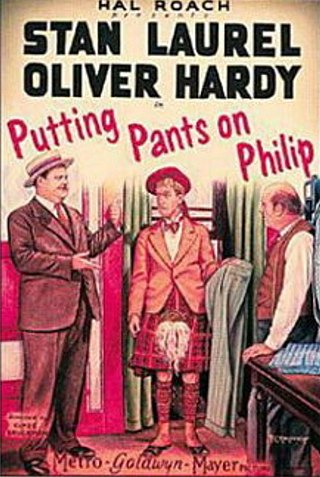
Putting Pants On Philip is a silent short film starring British/American comedy duo Laurel and Hardy. Made in 1927, it is their first official film together as a team.
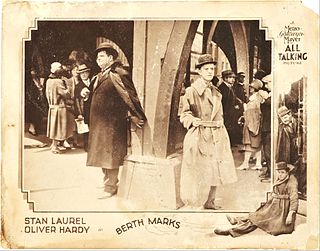
Berth Marks is the second sound film starring Laurel and Hardy and was released on June 1, 1929.
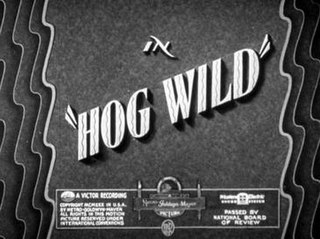
Hog Wild is a 1930 American pre-Code Laurel and Hardy film, directed by James Parrott.

County Hospital is a Laurel and Hardy short film made in 1932. It was directed by James Parrott, produced by Hal Roach and distributed by Metro-Goldwyn-Mayer. Ollie is in hospital with a broken leg, Stan comes to visit and ends up getting Ollie kicked out; on the way home Stan crashes the car.
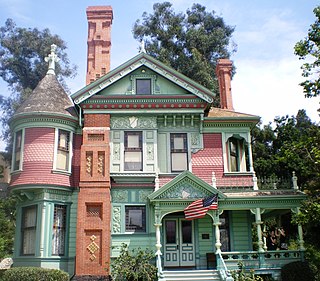
Heritage Square Museum is a living history and open-air architecture museum located beside the Arroyo Seco Parkway in the Montecito Heights neighborhood of Los Angeles, California, in the southern Arroyo Seco area. The living history museum shows the story of development in Southern California through historical architectural examples.

Lankershim Boulevard is a major north-south arterial road the runs for 7.5 miles (12.1 km) in the eastern San Fernando Valley in the Los Angeles, California.

The Los Angeles Fire Department Museum and Memorial is located at Old Engine Co. No. 27, also known as Fire Station No. 27, on Cahuenga Boulevard in Hollywood. The museum houses old fire engines and fire apparatus, some dating from the 1880s. The museum also houses a reference library and fire safety learning center. The building was named a Los Angeles Cultural-Heritage Monument in 1976 and was listed in the National Register of Historic Places in 1985. The Fallen Firefighters Memorial in front of the station consists of a memorial wall listing all of the Los Angeles firefighters who have died in the line of duty and five life-size statues of firefighters.

Hale House is a Queen Anne style Victorian mansion built in 1887 in the Highland Park section of northeast Los Angeles, California. It has been described as "the most photographed house in the entire city", and "the most elaborately decorated". In 1966, it was declared a Historic-Cultural Monument, and in 1972 it was listed on the National Register of Historic Places. The house was relocated in 1970 to the Heritage Square Museum in Montecito Heights where it remains open to the public.

Watts Station is a train station built in 1904 in Watts, Los Angeles, California. It was one of the first buildings in Watts, and for many years, it was a major stop for the Pacific Electric Railway's "Red Car" service between Los Angeles and Long Beach. It was the only structure that remained intact when stores along 103rd Street in Watts were burned in the 1965 Watts riots. Remaining untouched in the middle of the stretch of street that came to be known as "Charcoal Alley", the station became a symbol of continuity, hope, and renewal for the Watts community. It has since been declared a Los Angeles Historic-Cultural Monument and is listed on the National Register of Historic Places.

The Old Warner Brothers Studio, now known as the Sunset Bronson Studios, is a motion picture, radio and television production facility located on Sunset Boulevard in Hollywood, Los Angeles, California. The studio was the site where the first talking feature film, The Jazz Singer, was filmed in 1927.

The Sun Down Limited is a 1924 American short silent comedy film directed by Robert F. McGowan. It was the 30th Our Gang short subject to be released. The title is a play on the Southern Pacific Railroad's Sunset Limited train service. The Sun Down Limited was remade in 1929 during the sound era as Railroadin'.
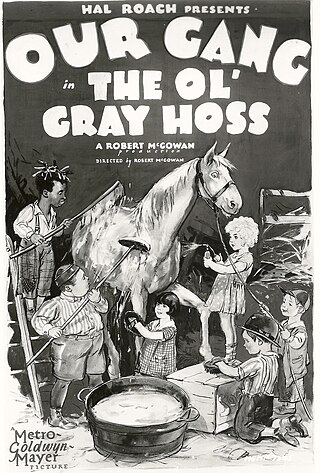
The Ol' Gray Hoss is a 1928 Our Gang short silent comedy film directed by Anthony Mack. It was the 78th Our Gang short to be released.

Noisy Noises is a 1929 Our Gang short silent comedy film directed by Robert F. McGowan. It was the 82nd Our Gang short to be released.

Bouncing Babies is a 1929 Our Gang short comedy film directed by Robert F. McGowan. Produced by Hal Roach and released to theaters by Metro-Goldwyn-Mayer, it was the 92nd Our Gang short to be released.

Los Angeles Historic-Cultural Monuments are sites which have been designated by the Los Angeles, California, Cultural Heritage Commission as worthy of preservation based on architectural, historic and cultural criteria.

Palms station is an elevated light rail station on the E Line of the Los Angeles Metro Rail system. The station is located over the intersection of National Boulevard and Palms Boulevard in the Palms neighborhood of Los Angeles, after which the station is named.

The Jim Henson Company Lot, formerly A&M Studios, is a studio property located just south of the southeast corner of North La Brea Avenue and Sunset Boulevard in Hollywood. Originally established by film star Charlie Chaplin, the property served as Charlie Chaplin Studios from 1917 to 1953, which later earned the site designation as a Los Angeles Historic-Cultural Monument. After being sold by Chaplin in 1953, the property went through several changes in ownership and has served at various times as the original studio of Hanna-Barbera Productions, Kling Studios, the Red Skelton Studios, the shooting location for the Adventures of Superman and Perry Mason television series. From 1966 to 1999, it was the headquarters for A&M Records and the location of A&M Recording Studios. Since 2000, it has the headquarters of The Jim Henson Company, including the Henson Soundstage and Henson Recording Studios.

Culver Boulevard is an east-west thoroughfare in the Westside region of Los Angeles County, California, connecting Venice Boulevard to the coast roads.



















